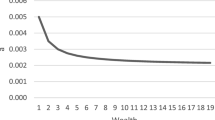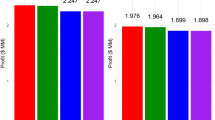Abstract
This paper presents a multiobjective model for crop planning in agriculture. The approach is based on portfolio theory. The model takes into account weather risks, market risks and environmental risks. Input data include historical land productivity data for various crops, soil types and yield response to fertilizer/pesticide application. Several environmental levels for the application of fertilizers/pesticides, and the monetary penalties for overcoming these levels, are also considered. Starting from the multiobjective model we formulate several single objective optimization problems: the minimum environmental risk problem, the maximum expected return problem and the minimum financial risk problem. We prove that the minimum environmental risk problem is equivalent to a mixed integer problem with a linear objective function. Two numerical results for the minimum environmental risk problem are presented.
Similar content being viewed by others
References
Alfandari, L., Lemalade, J. L., Nagih, A., & Plateau, G. (2009). A MIP flow model for crop-rotation planning in a sustainable development context. Annals of Operation Research. doi:10.1007/s10479-009-0553-0.
Annetts, J. E., & Audsley, E. (2002). Multiple objective linear programming for environmental farm planning. The Journal of the Operational Research Society, 53, 933–943.
Barrett, C., Reardon, T., & Webb, P. (2001). Nonfarm income diversification and household livelihood strategies in rural Africa: concepts, dynamics and policy implications. Food Policy, 26(4), 315–331.
Beneke, R. R., & Winterboer, R. (1973). Linear programming applications to agriculture. Ames Iowa: Iowa State University Press.
Blank, S. C. (1990). Returns to limited crop diversification. Western Journal of Agricultural Economics, 15, 204–212.
Blank, S. C., Carter, C. A., & McDonald, J. (1997). Is the market failing agricultural producers who wish to manage risks? Contemporary Economic Policy, 15, 103–112.
Blank, S. C. (2001). Producers get squeezed up the farming food chain: a theory of crop portfolio composition and land use. Review of Agricultural Economics, 23, 404–422.
Castellazzi, M. S., Wood, G. A., Burgess, P. J., Morris, J., Conrad, K. F., & Perry, J. N. (2008). A systematic representation of crop rotations. Agricultural Systems, 97(1–2), 26–33.
Collender, R. N. (1989). Estimation risk in farm planning under uncertainty. American Journal of Agricultural Economics, 71, 996–1002.
Collins, R., & Barry, P. (1986). Risk analysis with single-index portfolio models: an application to farm planning. American Journal of Agricultural Economics, 68, 152–161.
Detlefsen, N. K., & Jensen, A. L. (2007). Modelling optimal crop sequences using network flows. Agricultural Systems, 94(2), 566–572.
Dogliotti, S., Rossing, W. A. H., & Van Ittersum, M. K. (2003). ROTAT, a tool for systematically generating crop rotations. European Journal of Agronomy, 19(2), 239–250.
Ellis, F. (1998). Household strategies and rural livelihood diversification. Journal of Development Studies, 35(1), 1–38.
Ellis, F. (2000). Rural livelihoods and diversity in developing countries. Oxford: Oxford University Press.
El-Nazer, T., & McCarl, B. A. (1986). The choice of crop rotation: a modeling approach and case study. American Journal of Agricultural Economics, 68(1), 127–136.
Fafchamps, M. (1992). Cash crop production, food price volatility, and rural market integration in the Third World. American Journal of Agricultural Economics, 74(1), 90–99.
Figge, F. (2004). Bio-folio: applying portfolio theory to biodiversity. Biodiversity and Conservation, 13, 827–849.
Freund, R. J. (1956). The introduction of risk into a programming model. Econometrica, 24, 253–263.
Goland, C. (1993). Agricultural risk management through diversity: field scattering in Cuyo, Peru. Culture & Agriculture, 45/46, 8–13.
Haneveld, W. K., & Stegeman, A. W. (2005). Crop succession requirements in agricultural production planning. European Journal of Operations Research, 166(2), 406–429.
Hardaker, J. B., Huirne, R. B. M., Anderson, J. R., & Lien, G. (2004). Coping with Risk in Agriculture (2nd ed.). Oxfordshire: CABI Publishing.
Hazell, P. B. R. (1971). A linear alternative to quadratic and semivariance programming for farm planning under uncertainty. American Journal of Agricultural Economics, 53, 53–62.
Hazell, P. B. R., & Norton, R. D. (1986). Mathematical Programming for Economic Analysis in Agriculture. New York: Macmillan.
Heady, Earl O. (1954). Simplified presentation and logical aspects of linear programming technique. Journal of Farm Economics, 36(5), 1035–1048.
Hoanh, C. T., Lai, N. X., Hoa, V. T. K., et al. (2000). Can Tho Province case study: land use planning under the economic reform. In R. P. Roetter, H. Van Keulen, A. G. Laborte, H. H. Hoanh, & C. T. Van Laar (Eds.), SysNet Research Paper Series: No. 3. Synthesis of methodology development and case studies (pp. 47–52).
Johnson, S., Adams, R., & Perry, G. (1991). The on-farm costs of reducing groundwater pollution. American Journal of Agricultural Economics, 73, 1063–1073.
Lazimy, R. (1982). Mixed-integer quadratic programming. Mathematical Programming, 23(1), 332–349.
Lewandrowski, J. K., & Brazee, R. J. (1993). Farm programs and climate change. Climatic Change, 23(1), 1–20.
Markowitz, H. M. (1952). Portfolio selection. The Journal of Finance, 7(1), 77–91.
Mimouni, M., Zekri, S., & Flichman, G. (2000). Modelling the trade-offs between farm income and the reduction of erosion and nitrate pollution. Annals of Operation Research, 94(1–4), 91–103.
Nartea, G., & Bany, P. J. (1994). Risk efficiency and cost effects of geographic diversification. Review of Agricultural Economics, 16(3), 341–351.
Newbery, D. M. G., & Stiglitz, J. E. (1981). The theory of commodity price stabilization: a study in the economics of risk. Oxford: Clarendon Press.
Nidumolu, U. B., van Keulen, H., Lubbers, M., & Mapfumo, A. (2007). Combining multiple goal linear programming and inter-stakeholder communication matrix to generate land use planning options. Environmental Modelling & Software, 22, 73–83.
Park, T. A., & Florkowski, W. J. (2003). Selection of peach varieties and the role of quality attributes. Journal of Agricultural and Resource Economics, 28(1), 138–151.
Qiu, Z., Prato, T., & McCamley, F. (2001). Evaluating environmental risks using safety-first constraints. American Journal of Agricultural Economics, 83(2), 402–413.
Rădulescu, M., Rădulescu, S., & Rădulescu, C. Z. (2006). Mathematical models for optimal asset allocation. Bucureşti: Editura Academiei Române (in Romanian)
Rădulescu, M., Rădulescu, S., & Rădulescu, C. Z. (2009). Sustainable production technologies which take into account environmental constraints. European Journal of Operational Research, 193, 730–740.
Rădulescu, M., Rădulescu, C. Z., Turek Rahoveanu, M., & Zbăganu, Gh. (2010). A portfolio theory approach to fishery management. Studies in Informatics and Control, 19(3), 285–294.
Rafsnider, G. T., Driouchi, A., Tew, Bernard V., & Reid, D. W. (1993). Theory and application of risk analysis in an agricultural development setting: a Moroccan case study. European Review of Agricultural Economics, 20, 471–489.
Reeves, L. H., & Lilieholm, R. J. (1993). Reducing financial risk in agroforestry planning: a case study in Costa Rica. Agroforestry Systems, 21, 169–175.
Roche, M. J., & McQuinn, K. (2004). Riskier product portfolio under decoupled payments. European Review of Agricultural Economics, 31(2), 111–123.
Romero, C. (1976). Una aplicación del modelo de Markowitz a la selección de planes de variedades de manzanos en la provincia de Lérida. Revista de Estudios Agro-sociales, 97, 61–79.
Romero, C., & Rehman, T. (2003). Developments in Agricultural Economics: Vol. 11. Multiple criteria analysis for agricultural decisions (2nd ed.). Amsterdam: Elsevier.
Romero, C. (2000). Risk programming for agricultural resource allocation: a multidimensional risk approach. Annals of Operation Research, 94, 57–68.
Santos, L. M. R., Michelon, P., Arenales, M. N., & Santos, R. H. S. (2008). Crop rotation scheduling with adjacency constraints. Annals of Operation Research. doi:10.1007/s10479-008-0478-z. Online First™.
Schaefer, K. C. (1992). A portfolio model for evaluating risk in economic development projects, with an application to agriculture in Niger. Journal of Agricultural Economics, 43, 412–423.
Teague, M. L., Bernardo, D. J., & Mapp, H. P. (1995). Farm-level economic analysis incorporating stochastic environmental risk assessment. American Journal of Agricultural Economics, 77(1), 8–19.
Turvey, C. G., Driver, H. C., & Baker, T. G. (1988). Systematic and nonsystematic risk in farm portfolio selection. American Journal of Agricultural Economics, 70(4), 831–836.
Tziligakis, C. N. (1999). Relaxation and exact algorithms for solving mixed integer-quadratic optimization problems. Thesis (S.M.), Massachusetts Institute of Technology, Sloan School of Management, Operations Research Center.
Vizvári, B., Lakner, Z., Csizmadia, Z., & Kovács, G. (2009). A stochastic programming and simulation based analysis of the structure of production on the arable land. Annals of Operation Research. doi:10.1007/s10479-009-0635-z.
Weintraub, A., Romero, C., Bjørndal, T., & Epstein, R. (Eds.) (2007). International Series in Operations Research & Management Science: Vol. 99. Handbook of Operations Research in Natural Resources. Berlin: Springer.
Weintraub, A., Romero, C., Bjørndal, T., & Lane, D. (2001). Operational research models and the management of renewable natural resources: a review. Bergen Open Research Archive, Institute for Research in Economics and Business Administration (SNF), Working Paper 11/2001. http://bora.nhh.no/handle/2330/1371.
Wossink, G. A., de Koeijer, T. J., & Renkema, J. A. (1992). Environmental-economic policy assessment: a farm economic approach. Agricultural Systems, 39, 421–438.
Zekri, S., & Herruzo, A. C. (1994). Complementary instruments to EEC nitrogen policy in non-sensitive areas: a case study in southern Spain. Agricultural Systems, 46, 245–255.
Author information
Authors and Affiliations
Corresponding author
Rights and permissions
About this article
Cite this article
Rădulescu, M., Rădulescu, C.Z. & Zbăganu, G. A portfolio theory approach to crop planning under environmental constraints. Ann Oper Res 219, 243–264 (2014). https://doi.org/10.1007/s10479-011-0902-7
Published:
Issue Date:
DOI: https://doi.org/10.1007/s10479-011-0902-7




